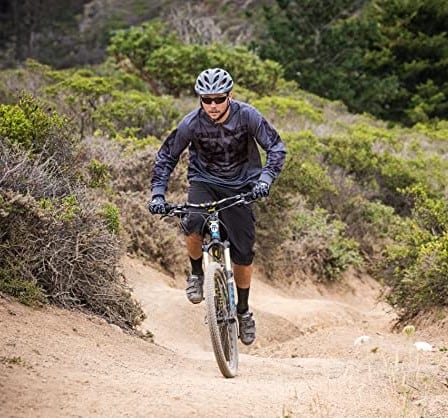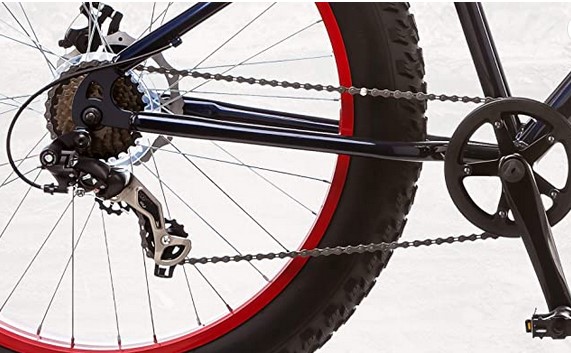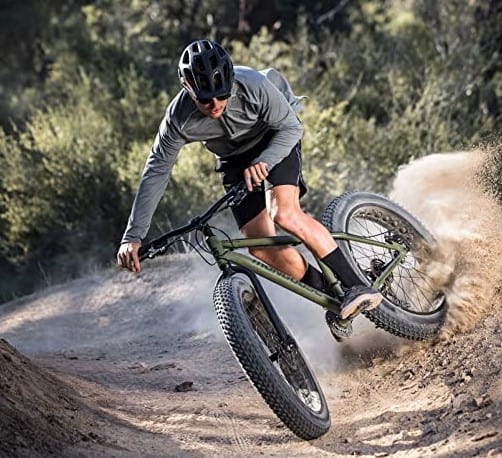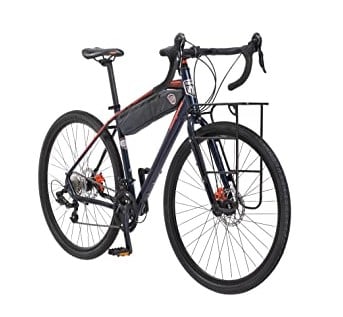Two-wheel adventures are always thrilling and memorable when you either have a touring bike or a mountain bike. But since these two bikes are different in design and components quality, how does a touring bike vs mountain bike compare?
Generally, a touring bike is best for traveling long distances, especially when you’ve to carry lots of loads. In contrast, a mountain bike is best for short-distance rides, especially on a mountainous landscape, but you don’t have to take any heavy loads.
But does that mean that you cannot use a mountain bike for touring?
I’ll answer this important question later in this post. Just to mention, yes, you can use a mountain bike for touring, but you’ll need to make a few adjustments. But before we can look at all that, let’s differentiate these two bikes.

What’s a Touring Bike?
As the name suggests, a touring bike is a bicycle designed for touring (or long travels). As a result, these bikes are pretty comfortable. But still, they are more robust in build to allow you to carry heavy loads on the go.
What’s a Mountain Bike?
As the name hints, a mountain bike is a bike designed for riding on a mountainous landscape. That includes forest trails, rocky gardens and fields, obstacles-hit grounds, and gravel surfaces. Mountain bikes are sturdy in build and quite rugged to take on such landscapes.
Plus, most come with a suspension to offer some bump cushioning and gears for quick shifting.
Touring Bike Vs Mountain Bike – Side by Side Comparison
Before we can discuss the difference between the two bikes, here’s a table summary for your consideration:
| Touring Bike | Mountain Bike | |
| Use | Long-distance travels and load carrying | Short distance off-road rides |
| Carry Capacity | Massive load carrying capacity | Smaller load carrying capacity |
| Mileage | More mileage | Less mileage |
| Geometry | More relaxed geometry due to a longer wheelbase | Less relaxed geometry due to a smaller wheelbase |
| Frame | Mostly steel | It comes in all frame types |
| Wheels | 700c wheels | 24-29 inch wheels |
| Handlebars | Flat and drop bars (mostly) | Flat bars |
| Gears | More gears | Fewer gears |
| Suspension | Absent mostly | Present |
| Dropper post | Absent | Present |
| Speed | Faster | Slower |
Let’s now discuss the differences under bike use, carry capacity, geometry, and bike features.:
1. Use
This is the main difference between these two bikes. While a touring bike is designed for long-distance fun rides, a mountain bike is designed for short-distance thrill off-road rides where you don’t have to carry any heavy load.
2. Carry Capacity
Unfortunately, MTBs are not meant to carry loads, and that sets them apart from touring bikes. An MTB will probably hold your water bottle, backpack (on your back), and saddlebag, and that’s about it.
In contrast, a touring bike comes with a cargo rack or allows you to attach one and carry loads in the front and back.
3. Mileage
Given that touring bikes are for riding long distances, they come with more mileage than mountain bikes. For example, a decent mountain bike may last you 10-15 miles while its touring counterpart can offer you up to 40-60 miles.
So, though touring bikes are not as rugged as mountain bikes, they guarantee more mileage.
4. Geometry
Interestingly, both bikes come with a relaxed geometry. The difference is that an MTB is less responsive when riding around an obstacle. You may have to change your position to conquer obstacles.
With touring bikes, you don’t have to change anything, making them more responsive. That’s primarily because touring bikes have a longer wheelbase, thus more stable.

5. Touring Vs Mountain Bike Features
These two bikes differ a lot in their features as follows:
a) Handlebars
Generally, mountain bikes come with flat bars wide enough to offer you more leverage when controlling the cycle on challenging terrains. Sadly, flat bars don’t provide you with many hand positions, which means you will likely get tired if you ride long distances.
That’s unlike touring bikes which come in both flat-bar and drop-bar options. Drop bars, which are the most popular, offer you more hand position to take an aerodynamic position, enabling you to go faster without tiring quickly.
That explains why it’s easier to go on long rides with a touring bike than an MTB.
b) Frame
Touring bikes mostly come in steel and are stronger and fatigue resistant, thus great for long rides. Steel is also easy to maintain and has shock absorption properties.
However, steel can be heavy, and that’s why mountain bikes mostly feature aluminum and high-end options in carbon and titanium frames. Only a few MTBs come in steel frames
c) Wheels
Touring bikes usually feature the road bike’s 700cc wheels but slightly wider tires (25-42mm) to offer you more bump cushioning.
Mountain bikes, however, come with 24-inch (for kids), 26 inch, 27.5 inch, and 29inch wheels to provide you with obstacle rolling power. The tires are also wider.
d) Gears
Mountain bikes mostly come with a 1X drivetrain. That means that they only have one front chainring with lots of cogs on the rear side. Overall, a 1X drivetrain is easier to maintain but sadly takes lots of leg effort to achieve optimum cadence.
Moreover, they have fewer parts which means they are less likely to trap obstacles. They, however, offer you fewer gears, which means you cannot go faster.
That’s unlike touring bikes which come with a 2X drivetrain that feature two front chainrings and lots of cogs on the back, which offer you more gears.
So, while the drivetrain requires extra maintenance, it provides you with more speed for having more gears and allows you to reach optimum cadence without suffering lots of fatigue.

e) Bike Suspension
MTBs offer you lots of suspension options. You can choose between front suspension (hard-tails), full suspension (double-suspension), or no suspension (rigid), depending on the terrain.
Overall, a suspension absorbs bumps to smoothen your ride.
Touring bikes, in contrast, ordinarily don’t have suspension as it makes them heavier and limits their ability to carry loads in the front.
Instead, they depend on their cushioned tires and robust steel frames for shock absorption.
f) Dropper Post
The work of a dropper post is to allow you to drop the bike seat out of its way to offer you more room to maneuver the bike.
But since you don’t have to adjust your body to ride around obstacles with a touring bike, they usually don’t come with dropper posts. You’ll find dropper posts on mountain bikes.
g) Lights
While touring bikes often feature lights to allow you to continue riding even at night, mountain bikes don’t feature them.
h) Fenders
MTBs usually lack fenders as they can easily trap obstacles in the roads and mountains. Touring bikes, in contrast, either come with fenders or allow you to fit them.
What Are the Similarities Between a Touring Bike and Mountain Bike?
While these two bikes are different in design and purpose, they have a few similarities that set them apart. For one, both bikes are heavier, stronger, and more robust than road bikes.
Secondly, both bikes can take on both the off-road (unpaved) and on-road (paved surfaces). Additionally, both bikes come with broader, cushioned tires that offer them more grip off-road.

Touring Bike Vs Mountain Bike Pros and Cons
Touring Bike
Pros
- Relaxed geometry
- More mileage
- Faster and stronger
- Load-carrying potential
- All-terrain wheels
Cons
- Not the best for rugged terrains
- Heavier than road bikes
- Slightly expensive
Mountain Bike
Pros
- Relaxed geometry
- All-terrain wheels
- Comfortable (comes with suspension)
- Commuter friendly
- Versatile for different uses
Cons
- Less mileage
- Heavier
Can You Use a Mountain Bike for Touring?
Mountain bikes are strong, hardy, and comfortable (given that they come with suspension). As a result, they can serve as touring bikes. The only issue is that you’ll have to pedal more, given that they are slower and don’t come with as many gears as touring bikes.
Also, you may have to take a few breaks between your rides as it’s easier to suffer fatigue on a mountain bike than on a touring bike. On that note, find the best mountain bike for touring on the hotlist below:
- Schwinn Bonafide Mountain Bike – Best for men
- Switch High Timber Mountain Bike – Best for women
- Mongoose Dolomite Mountain Bike – Best for all-terrain touring
Note that you can view all the above bikes on Amazon.
You should note, however, that nothing beats a touring bike. If you want a touring-specific bike, you’ve to get a touring bike, and I recommend the Mongoose Men’s Elroy Adventure Bike (View on Amazon).
This touring bike comes with internal cable routing and drop-bars to offer you an aerodynamic advantage. Moreover, it enjoys a relaxed geometry and a 14-speed drivetrain to allow you to take on long roads.

How to Convert MTB to Touring Bike
Generally, I don’t advocate turning a new mountain bike into a touring bike. After all, it doesn’t make financial sense to buy a mountain bike and convert it into a touring bike when you could have used the money to get a new touring bike.
So, this guide is for converting an old MTB into a touring bike.
Here’s how to go about it:
- Pick a steel frame mountain bike, preferably with no suspension (road suspension)
- Check for mounts and racks, fenders, lights, mirrors, panniers, water cages, attachments and fit them if they are non-existence. A metal fabricator expert can help you with that
- Mount the necessary attachments
- Check for the condition of the wheels, drivetrain, and brakes
- Replace the MTB tires with 700c options
- Swap the handlebar to switch to drop bars, preferably
- Upgrade the bike saddle and pedals
What Other Bike Can You Use for Touring?
While nothing beats a touring bike when it comes to long rides, some gravel road bikes are hardy enough to allow you to go on a long-distance ride. One such bike is the Tommaso Siena Gravel Adventure Bike (View on Amazon).
This gravel bike is perfect for dirt touring and road touring and generally suits guys who are 5’2¨-5’6¨ tall. It is speedy, lightweight, and comfortable, and comes with robust all-terrain wheels, thus perfect for touring.
Relevant:
Touring Bike Vs Mountain Bike Closing Thought:
Now you know what sets a touring bike and a mountain bike apart. You can therefore go ahead and choose between the two cycles depending on your intended use. Hopefully, this guide will help you arrive at that decision seamlessly.